737 MAX Ungrounded and Back in the Air as Boeing Delivers First Jet in Nearly Two Years to United Airlines
by J. Kasper Oestergaard, European Correspondent, Forecast International.
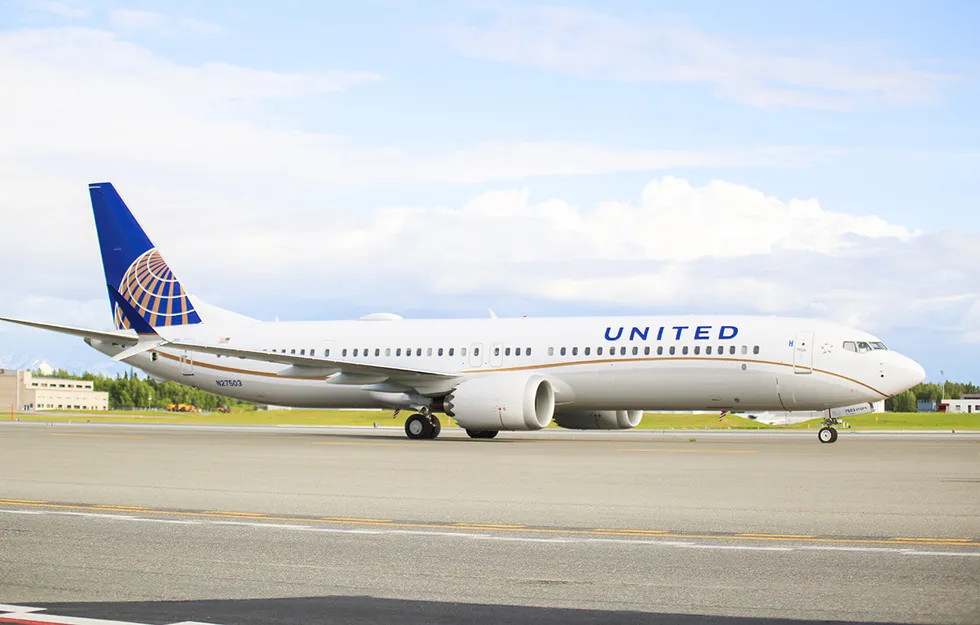
Boeing and Airbus delivered seven and 64 commercial jets in November 2020, compared to 24 and 78 deliveries, respectively, in the same month last year. With just 118 deliveries this year to date, Boeing is 227 shipments behind last year’s total for the first 11 months of the year. Airbus delivered a total of 477 jets from January to November, compared to 725 during the same period last year. Boeing’s deliveries have suffered for many months in the aftermath of two 737 MAX crashes and the subsequent suspension of deliveries and grounding of the fleet in March 2019. For the full year 2019, Boeing delivered 380 aircraft, while Airbus set a new all-time annual record, handing over 863 jets. Prior to this, Boeing had retained a deliveries lead over Airbus since 2012.
On November 18, following a comprehensive and methodical safety review process that took 20 months to complete, the FAA ungrounded the 737 MAX. An Airworthiness Directive spells out the requirements that must be met before U.S. carriers can resume service, including the installation of software enhancements, completing wire separation modifications, conducting pilot training, and accomplishing thorough de-preservation activities that will ensure that previously grounded jets are ready for service. On December 9, Boeing delivered the first 737 MAX in almost two years, to United Airlines. On the same day, Brazilian airline GOL performed the first scheduled 737 MAX passenger flight since March 2019. However, the 737 MAX remains grounded in Europe and China. The European Union Aviation Safety Agency (EASA) expects to lift its grounding in January, whereas the Civil Aviation Administration of China (CAAC) has not yet set a timetable for the aircraft’s return to service.
In November, Boeing’s seven aircraft shipments included two 737NGs, one 747-8, one 767, and three 777s. Production of the 737 MAX was suspended from January this year until the end of May, when Boeing announced it had commenced low-rate production of the aircraft. Boeing expects the 737 MAX production rate to gradually increase to 31 per month by early 2022, with further increases as market demand allows. Prior to the 737 MAX production suspension, Boeing was manufacturing the jet at a reduced rate of 42 per month and had produced and shipped 387 jets. Boeing has announced that the 787 production rate is being reduced from 14 per month (rate at the start of 2020) to just six per month during 2021. On October 1, Boeing announced it will be moving all 787 production to South Carolina by mid-2021. The combined 777/777X production rate will be reduced to two per month in 2021. Production rate assumptions have not changed for the 747 and 767 programs.
In November, Airbus delivered 64 jets, including two A220s, 54 A320s (2 CEO / 52 NEO), one A330, and seven A350s. For the full year 2019, Airbus handed over 642 A320 family aircraft, of which 551 were NEOs, while also delivering a record 112 A350s. Prior to the COVID-19 pandemic, Airbus was targeting a 5 percent A320 rate increase to 63 jets per month from 2021 and was also discussing a further ramp-up with its supply chain that could have brought the production rate up to as high as 67 aircraft per month, or 804 per year, by 2023. This would have put the company within reach of a total of 1,000 jets deliveries per year. These plans have now been shelved. Due to COVID-19, Airbus has cut production on several programs and is looking to hold underlying jet output at 40 percent below pre-pandemic plans for two years. The A320 production rate has been reduced to 40 aircraft per month, down from an average of over 53 aircraft per month in 2019. Recently, however, Airbus confirmed that the company is considering an increase in production to 47 A320neo jets per month in the second half of 2021. The A330 and A350 programs have been reduced to a rate of two and six aircraft per month, respectively. No rate cut has been announced for the A220 or A380.
Turning to the orders race, in November, Boeing booked two orders for a total of 27 jets but also reported 88 737 MAX cancellations. Orders in November included a new order for 25 737 MAX 10s from Virgin Australia; however, the airline at the same time canceled an existing order for 48 737 MAX jets in a move to push back deliveries. Also, Boeing Defense, Space & Security (BDS) ordered two 767-2Cs for the Japan KC-46 tanker program. Year-to-date, Boeing has accumulated 94 gross orders (548 cancellations => -454 net new orders). For the full year 2019, Boeing booked 243 gross orders (330 cancellations => -87 net new orders).

In November, Airbus booked no new orders and reported 11 A220 cancellations. For 2020 to date, Airbus has accumulated 381 gross orders (84 cancellations => net of 297). For the full year 2019, Airbus landed 1,131 gross orders (363 cancellations => net of 768), thereby retaking the orders crown from Boeing. In 2018, Airbus booked a total of 747 net new orders and 831 gross orders, thereby losing the 2018 orders race. Prior to this, Airbus had retained an orders lead over its rival every year since 2012.
At the end of November, Airbus reported a backlog of 7,302 jets, of which 6,564, or 88 percent, were A220 and A320ceo/neo family narrowbodies. This is 423 aircraft below the company’s all-time backlog record of 7,725 aircraft set in January 2020. By the end of November 2020, Boeing’s backlog (total unfilled orders before ASC 606 adjustment) was 5,053 aircraft, of which 4,082, or 81 percent, were 737 NG/MAX narrowbody jets. Boeing’s all-time backlog high of 5,964 aircraft was set in August 2018. The number of Airbus aircraft to be built and delivered represents 8.5 years of shipments at the 2019 production level. In comparison, Boeing’s backlog would “only” last 6.3 years at the 2018 level, which we use as a proxy for 2019 due to the severe drop in 737 MAX deliveries. This year to date, Boeing’s book-to-bill ratio, calculated as net new orders divided by deliveries, is negative due to cancellations exceeding gross orders. Airbus’ book-to-bill ratio is 0.62. In 2019, Boeing’s book-to-bill ratio was negative, while Airbus reported a book-to-bill ratio of 0.89.
2020 Forecast
Forecast International’s Platinum Forecast System is a breakthrough in forecasting technology that provides 15-year production forecasts. The author has used the Platinum Forecast System to retrieve the latest delivery forecasts and, for 2020, Forecast International’s analysts currently expect Boeing and Airbus to deliver 198 and 517 commercial jets, respectively.
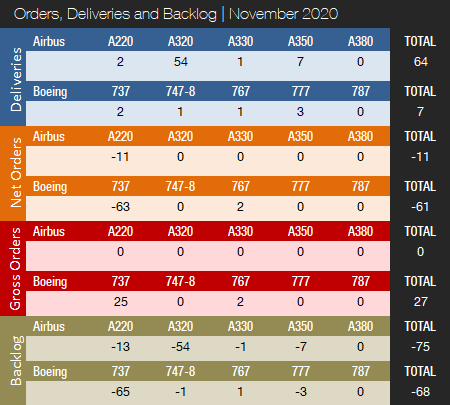
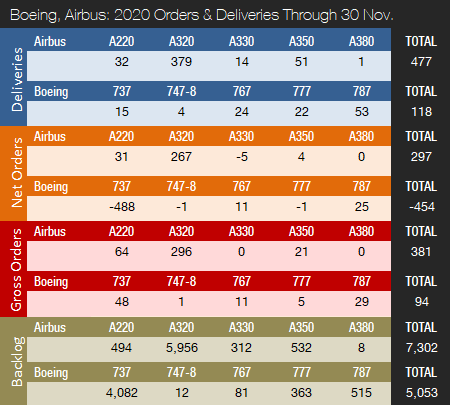
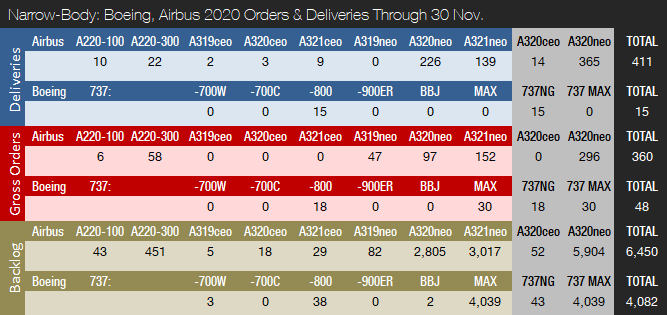
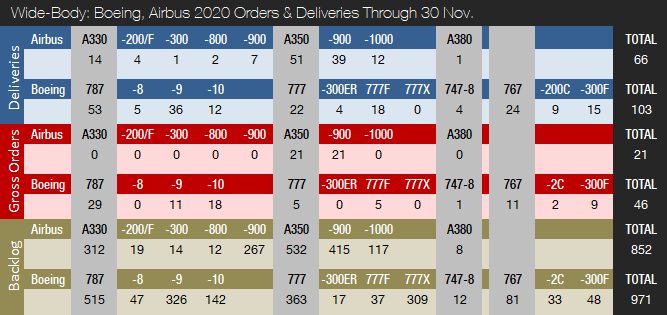
Note: The 777-300ER backlog includes one 777-200LR.
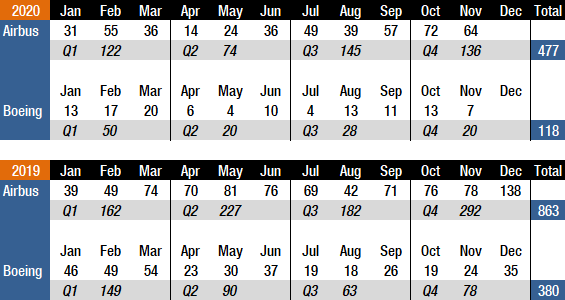
References:
- https://www.forecastinternational.com/platinum.cfm
- http://www.boeing.com/commercial/#/orders-deliveries
- https://www.airbus.com/aircraft/market/orders-deliveries.html
- https://www.faa.gov/news/updates/?newsId=93206
- https://boeing.mediaroom.com/2020-11-18-Boeing-Responds-to-FAA-Approval-to-Resume-737-MAX-Operations
- https://simpleflying.com/first-post-ungrounding-delivery/
- https://www.businessinsider.com/boeing-737-flies-first-flight-with-paying-passengers-since-2019-2020-12
- https://www.scmp.com/economy/china-economy/article/3113585/boeing-737-max-planes-return-china-riddled-uncertainty
- https://www.reuters.com/article/us-boeing-737max-easa-idUSKBN2810KU
- https://www.flightglobal.com/airlines/virgin-australia-orders-25-boeing-737-max-10s-cancels-previous-deal/141499.article
Forecast International’s Civil Aircraft Forecast covers the rivalry between Airbus and Boeing in the large airliner sector; the emergence of new players in the regional aircraft segment looking to compete with Bombardier, Embraer, and ATR; and the shifting dynamics within the business jet market as aircraft such as the Bombardier Global 7000, Cessna Hemisphere, and Gulfstream G600 enter service. Also detailed in this service, are the various market factors propelling the general aviation/utility segment as Textron Aviation, Cirrus, Diamond, Piper, and a host of others battle for sales and market share. An annual subscription includes 75 individual reports, most with a 10-year unit production forecast. Pricing begins at $2,295, with discounted full-library subscriptions available. Click here to learn more.

Based in Denmark, Joakim Kasper Oestergaard is Forecast International’s AeroWeb and PowerWeb Webmaster and European Editor. In 2008, he came up with the idea for what would eventually evolve into AeroWeb. Mr. Oestergaard is an expert in aerospace & defense market intelligence, fuel efficiency in civil aviation, defense spending and defense programs. He has an affiliation with Terma Aerostructures A/S in Denmark – a leading manufacturer of composite and metal aerostructures for the F-35 Lightning II. Mr. Oestergaard has a Master’s Degree in Finance and International Business from the Aarhus School of Business – Aarhus University in Denmark.
A military history enthusiast, Richard began at Forecast International as editor of the World Weapons Weekly newsletter. As the Internet grew in importance as a research tool, he helped design the company's Forecast Intelligence Center and currently coordinates the EMarket Alert newsletters for clients. Richard also manages social media efforts, including two new blogs: Defense & Security Monitor, covering defense systems and international issues, and Flight Plan, which focuses on commercial aviation and space systems. For over 30 years, Richard has authored the Defense & Aerospace Companies, Volume I (North America) and Volume II (International) services. The two books provide detailed data on major aerospace and defense contractors. He also edits the International Contractors service, a database that tracks all the contractors involved in the programs covered in the FI library. More recently he was appointed Manager, Information Services Group (ISG), a new unit that encompasses developing outbound content for both Forecast International and Military Periscope.



